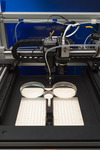| Name | Phone | |
|---|---|---|
| Klug, Nathalie | +49 721 608-23827 | nathalie klug ∂does-not-exist.kit edu |
| Kramer, Markus | +49 721 608-23827 | markus kramer ∂does-not-exist.kit edu |
| Pylatiuk, Christian | pylatiuk ∂does-not-exist.kit edu | |
| Wührl, Lorenz | +49 721 608-23827 | lorenz wuehrl ∂does-not-exist.kit edu |
| 3 additional persons visible within KIT only. | ||
| VIRTUAL MUSEUM | The VIRTUAL MUSEUM project sets a milestone in the digitization of museum collections of fossil and modern organisms. |
|
| PlastoView – Detection of microplastics in waters | Water quality is vital for maintaining ecosystems and human existence. However, it is threatened by the presence of microplastics. The “PlastoView” project is dedicated to developing innovative image-based methods for monitoring both, micrororganisms like plankton and microplastics. These methods will be implemented in a novel, cost-effective mobile system. |
|
 |
FORSAID – Forest surveillance with artificial intelligence and digital technologies | Project name (acronym): FORest Surveillance with Artificial Intelligence and Digital technologies (FORSAID) |
 |
3D modeling for biodiversity research | Biodiversity is one of the most important components for the functioning of global ecosystems and represents the basis for the existence and future of mankind. Nevertheless, so far only about 10-20% of all species are known and their function in the ecosystem described. In close cooperation with the Center for Integrative Biodiversity Discovery at the Museum of Natural History Berlin, new methods are being developed to digitize large insect collections and automatically determine their species. In this way, changes in the ecosystem can be detected. |
 |
Biohandling |
Model organisms such as the eggs of the zebrafish (Danio rerio) help to better understand the development of tumors and genetic diseases and to treat them more effectively. In order to find new suitable drugs or methods for treating these diseases, the sensitive eggs must first be sorted and then microscoped. Both can be automated through the use of specially developed laboratory robots. In addition, by coupling fluorescent dyes, cells can be specifically stained and made more visible. Subsequently, any changes from the normal development of fish eggs must be detected and classified using AI. The robots, fluorescence microscopes and analysis software required for this are being developed at IAI. |
 |
DiversityScanner – Sorting robot for biodiversity research | A fully automated sorting robot for small insects is developed in close cooperation with the Leibniz Institute for Evolutionary and Biodiversity Research in Berlin, that can classify and sort 14 different insects using machine learning methods. The quantification of insects from collected trap samples is necessary to identify threatened insect species and to take appropriate preventive measures. |
 |
Canary Pass – Gas sensors in medicine | Printed, flexible sensors for measuring in-vivo ozone concentrations in tissue are designed. Additionally reference systems for calibrating new gas sensors are developed. |
 |
Zebrafish Heartbeat Analysis | Open Science software is developed to analyze parameters of zebrafish heartbeat such as: heart rate, rhythmicity, fractional shortening and heart wall thickness automatically from videos of zebrafish hearts. |
 |
Automated Microscopy |
 |
Robot and Computer Assisted Microscopy |
 |
Body Energy Harvesting |
 |
Orthojacket |
 |
Fluidhand |
 |
Bionic Endoscopy |
 |
Transcranial magnetic stimulation |

